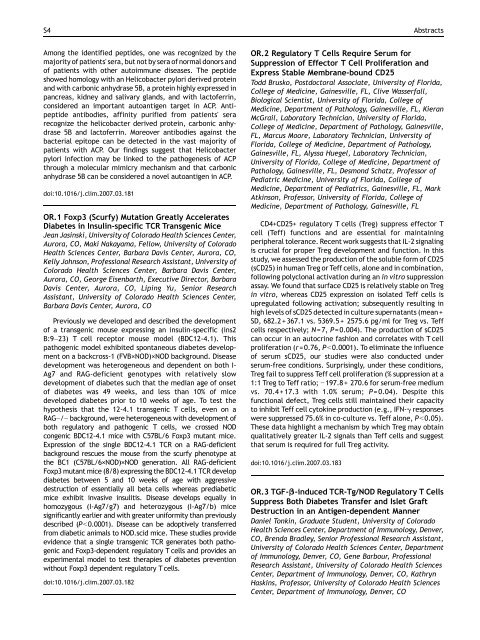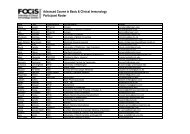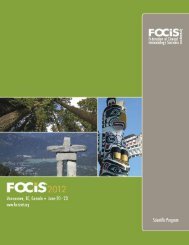Oral Presentations - Federation of Clinical Immunology Societies
Oral Presentations - Federation of Clinical Immunology Societies
Oral Presentations - Federation of Clinical Immunology Societies
Create successful ePaper yourself
Turn your PDF publications into a flip-book with our unique Google optimized e-Paper software.
S4 Abstracts<br />
Among the identified peptides, one was recognized by the<br />
majority <strong>of</strong> patients' sera, but not by sera <strong>of</strong> normal donors and<br />
<strong>of</strong> patients with other autoimmune diseases. The peptide<br />
showed homology with an Helicobacter pylori derived protein<br />
and with carbonic anhydrase 5B, a protein highly expressed in<br />
pancreas, kidney and salivary glands, and with lact<strong>of</strong>errin,<br />
considered an important autoantigen target in ACP. Antipeptide<br />
antibodies, affinity purified from patients' sera<br />
recognize the helicobacter derived protein, carbonic anhydrase<br />
5B and lact<strong>of</strong>errin. Moreover antibodies against the<br />
bacterial epitope can be detected in the vast majority <strong>of</strong><br />
patients with ACP. Our findings suggest that Helicobacter<br />
pylori infection may be linked to the pathogenesis <strong>of</strong> ACP<br />
through a molecular mimicry mechanism and that carbonic<br />
anhydrase 5B can be considered a novel autoantigen in ACP.<br />
doi:10.1016/j.clim.2007.03.181<br />
OR.1 Foxp3 (Scurfy) Mutation Greatly Accelerates<br />
Diabetes in Insulin-specific TCR Transgenic Mice<br />
Jean Jasinski, University <strong>of</strong> Colorado Health Sciences Center,<br />
Aurora, CO, Maki Nakayama, Fellow, University <strong>of</strong> Colorado<br />
Health Sciences Center, Barbara Davis Center, Aurora, CO,<br />
Kelly Johnson, Pr<strong>of</strong>essional Research Assistant, University <strong>of</strong><br />
Colorado Health Sciences Center, Barbara Davis Center,<br />
Aurora, CO, George Eisenbarth, Executive Director, Barbara<br />
Davis Center, Aurora, CO, Liping Yu, Senior Research<br />
Assistant, University <strong>of</strong> Colorado Health Sciences Center,<br />
Barbara Davis Center, Aurora, CO<br />
Previously we developed and described the development<br />
<strong>of</strong> a transgenic mouse expressing an insulin-specific (ins2<br />
B:9–23) T cell receptor mouse model (BDC12-4.1). This<br />
pathogenic model exhibited spontaneous diabetes development<br />
on a backcross-1 (FVB×NOD)×NOD background. Disease<br />
development was heterogeneous and dependent on both I-<br />
Ag7 and RAG-deficient genotypes with relatively slow<br />
development <strong>of</strong> diabetes such that the median age <strong>of</strong> onset<br />
<strong>of</strong> diabetes was 49 weeks, and less than 10% <strong>of</strong> mice<br />
developed diabetes prior to 10 weeks <strong>of</strong> age. To test the<br />
hypothesis that the 12-4.1 transgenic T cells, even on a<br />
RAG−/− background, were heterogeneous with development <strong>of</strong><br />
both regulatory and pathogenic T cells, we crossed NOD<br />
congenic BDC12-4.1 mice with C57BL/6 Foxp3 mutant mice.<br />
Expression <strong>of</strong> the single BDC12-4.1 TCR on a RAG-deficient<br />
background rescues the mouse from the scurfy phenotype at<br />
the BC1 (C57BL/6×NOD)×NOD generation. All RAG-deficient<br />
Foxp3 mutant mice (8/8) expressing the BDC12-4.1 TCR develop<br />
diabetes between 5 and 10 weeks <strong>of</strong> age with aggressive<br />
destruction <strong>of</strong> essentially all beta cells whereas prediabetic<br />
mice exhibit invasive insulitis. Disease develops equally in<br />
homozygous (I-Ag7/g7) and heterozygous (I-Ag7/b) mice<br />
significantly earlier and with greater uniformity than previously<br />
described (Pb0.0001). Disease can be adoptively transferred<br />
from diabetic animals to NOD.scid mice. These studies provide<br />
evidence that a single transgenic TCR generates both pathogenic<br />
and Foxp3-dependent regulatory T cells and provides an<br />
experimental model to test therapies <strong>of</strong> diabetes prevention<br />
without Foxp3 dependent regulatory T cells.<br />
doi:10.1016/j.clim.2007.03.182<br />
OR.2 Regulatory T Cells Require Serum for<br />
Suppression <strong>of</strong> Effector T Cell Proliferation and<br />
Express Stable Membrane-bound CD25<br />
Todd Brusko, Postdoctoral Associate, University <strong>of</strong> Florida,<br />
College <strong>of</strong> Medicine, Gainesville, FL, Clive Wasserfall,<br />
Biological Scientist, University <strong>of</strong> Florida, College <strong>of</strong><br />
Medicine, Department <strong>of</strong> Pathology, Gainesville, FL, Kieran<br />
McGrail, Laboratory Technician, University <strong>of</strong> Florida,<br />
College <strong>of</strong> Medicine, Department <strong>of</strong> Pathology, Gainesville,<br />
FL, Marcus Moore, Laboratory Technician, University <strong>of</strong><br />
Florida, College <strong>of</strong> Medicine, Department <strong>of</strong> Pathology,<br />
Gainesville, FL, Alyssa Huegel, Laboratory Technician,<br />
University <strong>of</strong> Florida, College <strong>of</strong> Medicine, Department <strong>of</strong><br />
Pathology, Gainesville, FL, Desmond Schatz, Pr<strong>of</strong>essor <strong>of</strong><br />
Pediatric Medicine, University <strong>of</strong> Florida, College <strong>of</strong><br />
Medicine, Department <strong>of</strong> Pediatrics, Gainesville, FL, Mark<br />
Atkinson, Pr<strong>of</strong>essor, University <strong>of</strong> Florida, College <strong>of</strong><br />
Medicine, Department <strong>of</strong> Pathology, Gainesville, FL<br />
CD4+CD25+ regulatory T cells (Treg) suppress effector T<br />
cell (Teff) functions and are essential for maintaining<br />
peripheral tolerance. Recent work suggests that IL-2 signaling<br />
is crucial for proper Treg development and function. In this<br />
study, we assessed the production <strong>of</strong> the soluble form <strong>of</strong> CD25<br />
(sCD25) in human Treg or Teff cells, alone and in combination,<br />
following polyclonal activation during an in vitro suppression<br />
assay. We found that surface CD25 is relatively stable on Treg<br />
in vitro, whereas CD25 expression on isolated Teff cells is<br />
upregulated following activation; subsequently resulting in<br />
high levels <strong>of</strong> sCD25 detected in culture supernatants (mean +<br />
SD, 682.2+367.1 vs. 5369.5+ 2575.6 pg/ml for Treg vs. Teff<br />
cells respectively; N=7, P=0.004). The production <strong>of</strong> sCD25<br />
can occur in an autocrine fashion and correlates with T cell<br />
proliferation (r=0.76, Pb0.0001). To eliminate the influence<br />
<strong>of</strong> serum sCD25, our studies were also conducted under<br />
serum-free conditions. Surprisingly, under these conditions,<br />
Treg fail to suppress Teff cell proliferation (% suppression at a<br />
1:1 Treg to Teff ratio; −197.8+ 270.6 for serum-free medium<br />
vs. 70.4+17.3 with 1.0% serum; P=0.04). Despite this<br />
functional defect, Treg cells still maintained their capacity<br />
to inhibit Teff cell cytokine production (e.g., IFN-γ responses<br />
were suppressed 75.6% in co-culture vs. Teff alone, Pb0.05).<br />
These data highlight a mechanism by which Treg may obtain<br />
qualitatively greater IL-2 signals than Teff cells and suggest<br />
that serum is required for full Treg activity.<br />
doi:10.1016/j.clim.2007.03.183<br />
OR.3 TGF-β-induced TCR-Tg/NOD Regulatory T Cells<br />
Suppress Both Diabetes Transfer and Islet Graft<br />
Destruction in an Antigen-dependent Manner<br />
Daniel Tonkin, Graduate Student, University <strong>of</strong> Colorado<br />
Health Sciences Center, Department <strong>of</strong> <strong>Immunology</strong>, Denver,<br />
CO, Brenda Bradley, Senior Pr<strong>of</strong>essional Research Assistant,<br />
University <strong>of</strong> Colorado Health Sciences Center, Department<br />
<strong>of</strong> <strong>Immunology</strong>, Denver, CO, Gene Barbour, Pr<strong>of</strong>essional<br />
Research Assistant, University <strong>of</strong> Colorado Health Sciences<br />
Center, Department <strong>of</strong> <strong>Immunology</strong>, Denver, CO, Kathryn<br />
Haskins, Pr<strong>of</strong>essor, University <strong>of</strong> Colorado Health Sciences<br />
Center, Department <strong>of</strong> <strong>Immunology</strong>, Denver, CO




